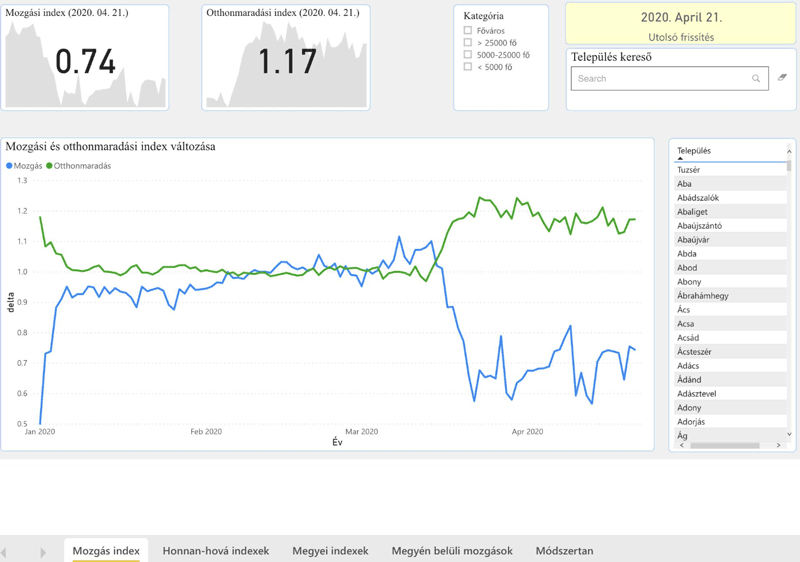by Peter Gaal, Miklos Szocska, Tamas Joo and Tamas Palicz (Semmelweis University, Budapest)
The analysis of routinely generated Big Data is increasingly seen as an inexpensive method to support evidence-based policymaking and implementation. Analysing routine data generated as a result of the use of mobile phones has long been recognised as a potential method to monitor population movement. This would provide invaluable information on the impact of social distancing measures that were implemented at an unprecedented scale during the COVID-19 pandemic [1]. While population movement monitoring on the basis of mobile phone use seems an obvious choice to support the management of the outbreak, several technical questions need addressing: in particular, the challenge of collating data from different mobile network providers. There are also data protection concerns, such as the need to comply fully with General Data Protection Regulation of the European Union (GDPR), which limits the feasibility of using the data in this way.
In a paper entitled “Putting (Big) Data in Action: Saving Lives with Countrywide Population Movement Monitoring Using Mobile Devices during the COVID-19 Crisis” [2], which has already been published as a preprint at MedRxiv and is under consideration for publication at Scientific Reports, we introduce a methodology, to assess the effectiveness of social distancing measures on the basis of routine call detail records, anonymised and aggregated at settlement level. While the use of mobile phone call detail records (CDR) to track population movement has been reported from several countries during the COVID-19 pandemic, to our knowledge, no detailed discussion of the methodology developed in the frame of these projects has been published to date.
In our study, based on datasets provided by all three main domestic telecommunication companies in Hungary, we provide a detailed introduction and analysis of our method, with which we have been able to overcome all the main feasibility limitations, and show that the CDR-based method is an effective and inexpensive tool to monitor population movement with good accuracy and resolution. In particular, GDPR compatibility has been ensured, not just by the anonymity of individual users’ data, but the aggregation of data on the level of settlements for a 24-hour period. In constructing the mobility and stay-at-home (resting) indices, the key methodological solutions have been: (i) Distinguishing between mobile devices showing an activity in a single location and those showing an activity in a pair of different Hungarian cities, (ii) the decision to compare the data with an appropriate reference period of activity before the outbreak, looking at the relative, rather than the absolute number, of location-changing or resting devices, and (iii) the integration of the datasets from three different mobile network providers.
The analysis of CDR data is not the only way that mobile phones can be used to monitor population movement. The smartphone-based method, which can also use GPS data to locate mobile phones, is more accurate for determining the geographical location of individual mobile phone users, but only as long as the user has a smartphone, the GPS sensor of the phone is turned on and the user has agreed to share the data. In our paper, we compared the two methods and concluded that the CDR-based solution is superior for monitoring mass population movement, while the latter is better for tracking individuals, for instance in contact tracing and during quarantine, so these are complementary, rather than competitive, tools in supporting the management of epidemics.
Given that the developed methodology integrated CDR data from three major European telecommunication companies, that the algorithms automatically process these huge routine databases into information easily interpreted by high level decision-makers, and that the process is standardised and fast enough to make it relevant for swift decision making, we are convinced that it can be easily adapted by other countries. We believe this methodology is an effective and inexpensive tool to support decision-makers in combating the epidemic; minimising loss of lives and damage to the economy. It should therefore be made available worldwide for any country interested in using it in their management of the pandemic. We are happy to share further technical details with governments interested in adapting our approach in their respective countries, but also across countries at the supranational level.

Figure 1: An example of the graphical presentation of changes in the Mobility (blue) and Stay-at-home (green) indices before and during the first wave of the COVID-19 epidemic.
The methodology being further developed in cooperation with the Artificial Intelligence Hungarian National Laboratory [L1] to expand its use in pandemic management: in particular to better understand the patterns of human interactions in the spread of the disease, to identify super-spreading events, and to evaluate the cost-effectiveness of interventions to prevent them.
The described research has received support from the Hungarian National Research, Development and Innovation Office, and the Research Excellence Programme of the Ministry for Innovation and Technology in Hungary through the Digital Biomarker thematic program of the Semmelweis University.
Link:
[L1] https://milab.hu/
References:
[1] K.H.Grantz, H.R. Meredith, D.A.T. Cummings, et al.: “The use of mobile phone data to inform analysis of COVID-19 pandemic epidemiology”, Nature Communications 11, 4961. https://doi.org/10.1038/s41467-020-18190-5
[2] M. K. Szocska, et al.: “Putting (Big) Data in Action: Saving Lives with Countrywide Population Movement Monitoring Using Mobile Devices during the COVID-19 Crisis, Preprint published at MedRxiv: https://medrxiv.org/cgi/content/short/2020.09.21.20194019v1, https://doi.org/10.1101/2020.09.21.20194019
Please contact:
Peter Gaal, Semmelweis University, Budapest, Hungary











